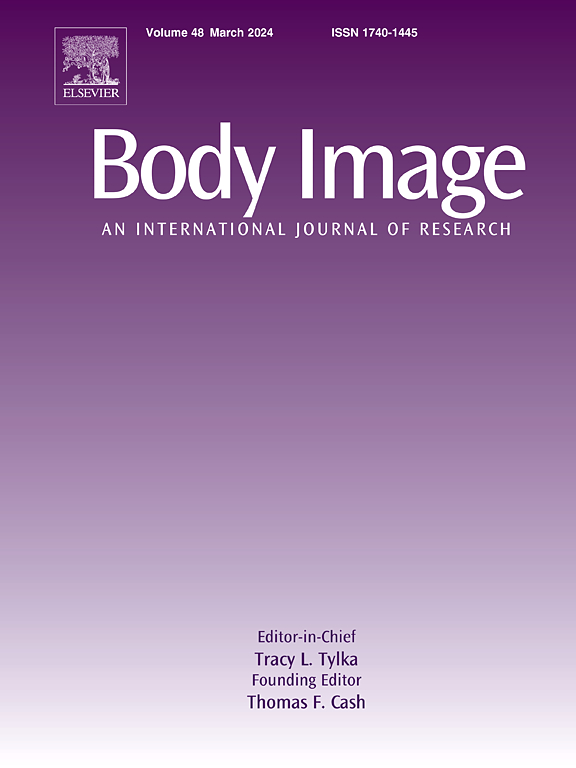A systematic review and meta-analysis on the temporal relationship between appearance comparisons and body dissatisfaction
IF 5.4
1区 心理学
Q1 PSYCHIATRY
引用次数: 0
Abstract
The co-occurrence of appearance comparison (AC) and body dissatisfaction (BD) is well-recognised, but there is no consensus on the direction of effects between the two constructs. We present findings from the first meta-analytic review of all longitudinal studies assessing the direction of effects between AC and BD. Furthermore, we provide a systematic review on studies that were not able to be included in the meta-analysis and on studies using an ecological momentary assessment (EMA) design. Systematic search following PRISMA guidelines identified 32 studies. Multilevel random-effects meta-analyses were conducted on 8 eligible studies and revealed small but significant effect sizes for the bidirectional relationship between AC and BD among women ( 0.077; 0.078). Further meta-regression analyses of female data showed that these effects were not moderated by time-lag but were weakly moderated by age and body mass index. A systematic review of the remaining 24 studies (6 longitudinal; 18 EMA) revealed nuances in AC, such as direction, are important to consider as they are differentially related to BD. Nevertheless, a bidirectional relationship was supported between AC, especially upward AC, and BD. Future research should prioritize assessing the longitudinal relationship between AC and BD to clarify how these constructs influence each other over time. A more nuanced view of AC processes, along with an investigation of factors that can influence the size and direction of the AC-BD relationship, is also needed to inform targeted prevention strategies.
关于外貌比较与身体不满意之间时间关系的系统回顾和荟萃分析
外貌比较(AC)和身体不满意(BD)并存的现象已得到广泛认可,但对于这两个概念之间的影响方向还没有达成共识。我们首次对所有评估 AC 和 BD 之间影响方向的纵向研究进行了荟萃分析综述,并提交了研究结果。此外,我们还对未能纳入荟萃分析的研究以及采用生态瞬间评估(EMA)设计的研究进行了系统回顾。按照PRISMA指南进行的系统性检索发现了32项研究。对 8 项符合条件的研究进行了多层次随机效应荟萃分析,结果显示,女性 AC 与 BD 之间双向关系的效应大小较小,但具有显著性(rAC→BD= 0.077;rBD→AC= 0.078)。对女性数据的进一步元回归分析表明,这些效应不受时滞的影响,但受年龄和体重指数的影响较弱。对其余 24 项研究(6 项纵向研究;18 项 EMA 研究)的系统回顾显示,AC 的细微差别(如方向)是需要考虑的重要因素,因为它们与 BD 的关系各不相同。然而,AC(尤其是向上 AC)与 BD 之间的双向关系得到了支持。未来的研究应优先评估交流和脑发育不良之间的纵向关系,以明确这些建构是如何随着时间的推移而相互影响的。此外,还需要对交流过程进行更细致的观察,并对可能影响交流-BD关系的大小和方向的因素进行调查,以便为有针对性的预防策略提供信息。
本文章由计算机程序翻译,如有差异,请以英文原文为准。
求助全文
约1分钟内获得全文
求助全文
来源期刊

Body Image
Multiple-
CiteScore
8.70
自引率
28.80%
发文量
174
期刊介绍:
Body Image is an international, peer-reviewed journal that publishes high-quality, scientific articles on body image and human physical appearance. Body Image is a multi-faceted concept that refers to persons perceptions and attitudes about their own body, particularly but not exclusively its appearance. The journal invites contributions from a broad range of disciplines-psychological science, other social and behavioral sciences, and medical and health sciences. The journal publishes original research articles, brief research reports, theoretical and review papers, and science-based practitioner reports of interest. Dissertation abstracts are also published online, and the journal gives an annual award for the best doctoral dissertation in this field.
 求助内容:
求助内容: 应助结果提醒方式:
应助结果提醒方式:


